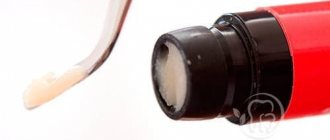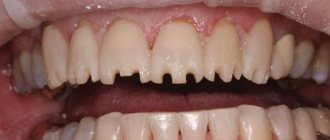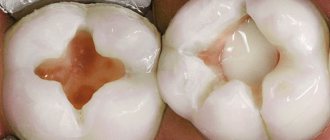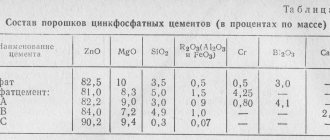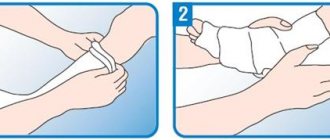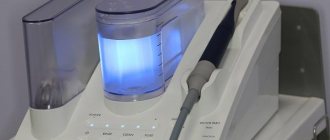Composition and properties of PCC
The product consists of two components: powder and liquid.
The powder is converted zinc oxide with the addition of magnesium oxide. The liquid consists of a 37% water-based solution of polyacrylic acid.
Properties:
- ensuring a chemical relationship with tooth tissue;
- the formation of a strong bond with the metal, especially if it has been sandblasted;
- carboxylate has low toxicity to the pulp.
The finished working solution has the appearance of a paste-like consistency, with a smooth and shiny surface.
Carboxylate cements have their advantages and disadvantages:
| Advantages | Flaws |
| According to biological characteristics, they are highly compatible with dental tissues | Has the property of dissolving in the mouth over time |
| They do not allow acids to pass through, which are formed during the hardening of the filling. | |
| Are not an irritant to the pulp | Insufficient strength |
| Good adhesion to hard tooth surfaces |
About the procedure
The name of the procedure “filling” comes from the Latin plumbum - “lead”. This is the replacement of certain defects in dental tissues with artificial material. The goal is to restore the anatomical shape of the tooth and return it to functionality. Today, both permanent and temporary filling materials are used for this purpose.
You might be interested in: Do they take you into the army with braces? How to brush teeth with braces
The filling can replace not only hard dental tissues, but also protect the pulp and apical periodontium from the effects of a number of unfavorable external factors.
The success of medical interventions preceding filling in this case is assessed by the usefulness and duration of preservation of the applied filling. Today, a whole host of materials are used for the procedure, differing in structure, purpose and properties.
Method of application
The material is used for fixing different types of inlays and crowns, small-sized prostheses - bridges, and orthodontic devices. Used for filling children's teeth, as well as for temporary fillings.
To mix polycarboxylate cement mortar, use a clean piece of glass and a spatula.
Just before mixing, drop the required amount of liquid base from a bottle with a dropper onto the glass. To prevent the liquid from evaporating, the bottle must be closed immediately. Then add the powder and quickly mix for about 30 seconds.
The powder must be added in portions, first dividing into two equal parts. First, one share is combined and mixed with the liquid for 15 seconds. Then add the second one and continue mixing until smooth (in the same time as the first).
The best ratio of powder to liquid is considered to be 0.4:0.2, respectively.
If the temperature in the room exceeds 22°C, then the dose of powder should be reduced or a little more liquid component should be added.
From the start of mixing, the prepared composition must be used within 1-2 minutes. An indicator can be the glossy and shiny surface of the prepared pasta.
The cement hardening time is 5-10 minutes. With more liquid, curing takes longer.
The rate of hardening depends on:
- correctly selected proportion of powder to liquid;
- reaction susceptibility of zinc oxide;
- particle size and the presence of additional impurities;
- polyacrylic acid content.
After 10-12 hours, the material completely hardens. Food can be taken no earlier than 4 hours after mouth treatment.
Filling tooth canals on video:
POLYCARBOXYLATE CEMENTS
Polycarboxylate cements were developed in the late 60s. They are used as insulating gaskets for fillings of silicate cements, amalgam and other materials.
Compound.
Consists of powder and liquid. The main part of the powder is zinc oxide, to which 1 to 5% magnesium oxide and calcium oxide are added. Some materials contain 1 to 40% aluminum oxide and small amounts of stannous fluoride or other fluoride. The liquid is a 40-50% aqueous solution of polyacrylic acid or a copolymer of acrylic acid with other organic acids, for example, itacic acid. The solution is viscous in nature, since the molecular weight of the polymer is from 30,000 to 50,000. In some brands of materials, polyacrylic acid is dried and added to the composition of the cement powder. In these cases, water is used to mix cement.
Properties.
The maximum strength of polycarboxylate cements is achieved 24 hours after mixing and is 55-85 MPa in compression, and 8-12 MPa in tension. Solubility in water ranges from 0.1 to 0.6%. If fluorides are present in cement, solubility in water is significantly reduced. Hardening time at a temperature of 37 degrees Celsius is 6-9 minutes. After mixing, the pH of the cement quickly rises to neutral.
Positive properties:
— high biological compatibility with dental tissues;
— impermeability to acids and monomers formed during the hardening of fillings;
— good adhesion to hard tooth tissues;
- practically do not irritate the tooth pulp.
Negative properties:
- low mechanical strength, therefore cannot be used for permanent fillings;
- poor chemical resistance, instability to the action of oral fluid, therefore the insulating gasket should not extend beyond the enamel.
Mode of application.
Polycarboxylate cement is mixed on the smooth side of a dry and clean glass plate using a spatula. The required amount of liquid from the dropper bottle is placed on a glass plate immediately before use. To avoid evaporation of the contents, the dropper bottle must be capped immediately after use. For pads, the optimal ratio is approximately 0.4 g of powder (1 scoop) and 0.2 g of liquid (2 drops). When the temperature in the workroom is above 22 degrees Celsius, the amount of powder should be reduced slightly or a little liquid added. Polycarboxylate cement should be mixed quickly - within 20-30 seconds. A portion of the powder is divided into two equal parts. The first part is combined with the liquid and kneaded for 15 seconds, then the remaining half of the powder is added and kneaded for another 15 seconds until a mass of homogeneous consistency is obtained. The resulting paste should be used within 1.5-2 minutes from the start of mixing. The paste can be used as long as its surface remains glossy and shiny. Polycarboxylate cement should be stored indoors, away from direct sunlight, at a temperature not exceeding 25 degrees Celsius.
Curing.
The reaction between zinc oxide and polyacrylic acid proceeds according to the following scheme:
zinc oxide + polyacrylic acid => zinc polyacrylate
After the interaction, a cross-linked zinc polyacrylate structure is formed.
The pronounced adhesion of polycarboxylate cements to hard dental tissues is due to the chemical bond of the carboxylate groups of polyacrylic acid with calcium in enamel and dentin. In addition, they form complex compounds with proteins of hard dental tissues.
Representatives of polycarboxylate cements are the following materials:
Belokor (VladMiVa company); Belokor (Raduga-R company), CARBOFINE (Spofa Dental company), Polycarboxylate cement (Stoma company), Polycarboxylate cement with potassium nitrate, Polycarboxylate cement (Medpolymer company), Adhesor Carbofine (Spofa Dental company), Aqualox (Voco company), Carbchem (PSP), Carboco (Voco), Carboxylatzement Bayer (Bayer), Cimex (DentAmerica), Durelon Powder (ESPE), Poly Carb (DCL), PolyCarb (PSP Dental), PR Scell Policarboxylate ( Pierre Holland), Selfast (Septodont company).
Description of materials.
Belokor (VladMiVa company); Belokor (Raduga-R company).
Polycarboxylate cement intended for lining under permanent fillings made of amalgam, gallodent, plastic and silicate cement, as well as for filling baby teeth, for fixing inlays, various types of crowns, small bridges, orthodontic appliances. Consists of powder and liquid. The powder is a modified zinc oxide, the liquid is an aqueous solution of polyacrylic acid. Belokor has pronounced adhesive properties, low solubility in the oral cavity, and does not irritate the tooth pulp.
Mode of application.
For gaskets for permanent fillings, as well as for filling teeth, the optimal ratio is 2 scoops of powder and 5-7 drops of liquid. For fixing inlays and various types of dentures, the optimal ratio is 2 scoops of powder and 8-10 drops of liquid.
Release form.
Powder 20 g, liquid 10 ml.
Polycarboxylate cement (Medpolymer company).
Indications for use:
— as an insulating lining under other filling materials (it can be used with all cements, amalgams, composites);
— for filling baby teeth and for temporary fillings;
— for fixing inlays, various types of crowns, small bridges, orthodontic appliances.
Compound.
Powder: modified zinc oxide, polyacrylic acid. The liquid is distilled water.
Mode of application.
The normal consistency of cement for fillings and gaskets is ensured by mixing 1 scoop of powder and 1-2 drops of water. The normal consistency of cement for fixation is ensured by mixing 1 scoop of powder and 3-4 drops of water. Mixing should be done quickly - no more than 30-40 seconds. Cement hardening time is 6-8 minutes.
The adhesive properties of the material require immediate rinsing of all tools used when working with it under running water.
Release form.
A jar of powder, a bottle of liquid, a measuring cup.
Aqualox (Voco)
Water-mixed carboxylate cement for lining and anchoring. It binds well to dentin and, due to its low acid content, does not cause irritation to the pulp. Aqualox provides good acid protection, has excellent physical properties, is stable and has a microphilic structure.
Release form:
powder 50 g with a bottle dispensing drops.
Carboco (Voco company)
Well proven carboxylate cement. Ultrafine powder with good physical and chemical properties. A universal set of shades and low acid content allow it to be used for linings and fixation of crowns, bridges, and inlays.
Release form:
combo pack of 50 g of powder and 20 ml of liquid, as well as an additional pack of 50 g of powder and an additional pack of 20 ml of liquid.
Cimex (DentAmerica) Indications for use:
— as a gasket under filling materials of all types;
— for temporary fillings;
— for filling baby teeth;
— for cementing crowns, bridges, facets, orthodontic braces.
Kneading.
Mixing time - 30 seconds. Working time with the material is 1 min 45 sec. For gaskets and fillings, the optimal ratio is 1 scoop of powder to 1 drop of liquid.
Selfast (Septodont)
Selfast is a polycarboxylate cement that has numerous advantages over conventional oxyphosphate cement:
— interacts well with dentin and metals;
— greater hardness with increased flexibility;
— physiological neutrality;
— dimensional stability after hardening;
— hardening time varies little depending on temperature and humidity.
Indicated as an isolating lining for the treatment of caries, as well as for fixation of all types of fixed prostheses: bridges, crowns, inlays, onlays, pins.
Method of application for insulating gasket.
Add 3 drops of liquid to 1 dosage spoon of powder and mix for 30 seconds. Operating time 3 minutes. Before introducing Selfast into the carious cavity, it should be thoroughly dried.
Note.
Selfast interacts well with metals, so immediately after mixing with a stainless steel spatula, the latter must be thoroughly cleaned. The mixture can be used as long as it is shiny.
Release form.
A box that contains 1 bottle of powder 60 g, 1 bottle of liquid 40 ml, 1 mixing block, 1 dosing spoon.
Popular brands and manufacturers
The brands and manufacturers presented in the table have proven themselves well:
| Name | Manufacturer |
| "Belokor" | VladMiVa |
| "Belokor" | Rainbow-R |
| "Carbofaine" | Spofa Dental |
| Polycarboxylate cement | Stoma |
| Polycarboxylate cement | Medpolymer |
| Polycarboxylate cement with potassium nitrate | Medpolymer |
| Adhesor Carbofine | Spofa Dental |
| Aqualox | Voko |
| Carboxylatzement Bayer | Bayer |
| Cimex | DentAmerica |
| Durelon Powder | ESPE |
| PolyCarb | PSP Dental |
| PR Scell Polycarboxylate | Pierre Holland |
| Selfast | Septodont |
| Carboxylatzement Bayer | Bayer |
Main clinical requirements
Both temporary filling materials and all of the above are subject to the same clinical requirements:
- The materials should not have a toxic effect on the hard tissues of the tooth, pulp, or mucous membranes of the oral cavity.
- Filling substances must be generally harmless to the body.
- Materials must have an antiseptic and anti-inflammatory effect.
- These substances directly prevent the penetration of both pathogenic microflora and toxins into the pulp.
- The materials have an anti-caries effect.
- They are characterized by low thermal conductivity, which prevents the dissolution of materials in saliva.
- Filling materials are chemically inert. In other words, they are resistant to such aggressive agents as alkalis and acids.
- Such substances are quite hard, mechanically strong, wear-resistant, and also have good aesthetic properties.
- The materials do not change the shade of the tooth and do not lose their original color over time.
- Filling substances do not cause the appearance of galvanic currents in the oral cavity.
- The materials do not change volume and shape during the process of hardening. At the same time, they set quickly and have high adhesion to tooth tissues.
- By their nature, these substances are radiopaque.
Studying materials
You may be interested in: How to remove braces from teeth: a description of the procedure. How long to wear braces and what to do after removal
Filling materials for temporary fillings, like all others, are thoroughly studied before their direct use in dental clinics. The ongoing research can be divided into three vectors:
- Physical and mechanical tests.
- Study of biological properties of substances.
- Clinical trials.
The physical and mechanical characteristics of filling materials for temporary fillings are based on the results of a number of laboratory tests:
- Determination of material consistency.
- Increase in the temperature of the material during hardening.
- Volumetric changes in a substance during solidification.
- Color fastness.
- Water absorption.
- Determination of the working time for mass hardening.
- Solubility in water and other media.
- Hardness.
- Opacity.
- Adhesion.
- Abrasion resistance and other characteristics.
Biological tests of temporary filling materials (for root canals as well) make it possible to reveal their indifference both to the body as a whole and to tooth tissues. The types of biotests carried out are aimed at determining the following:
- General toxicity of the substance when administered orally.
- Chronic toxicity of the material.
- Local toxicity.
- Specific sensitization.
Biological tests in this case are carried out on experimental animals. This makes it possible to obtain the most reliable data on the bioproperties of temporary filling material (for root canals, hard dental tissues, etc.), and to substantiate recommendations for further clinical trials.
For the latter, specific facts from individual observations of dental practice are important. This allows us to judge the advantages and disadvantages of each material under the conditions of its actual use and operation.
You may be interested in: How to treat gumboil in dentistry: methods and preparations
"Dentin paste"
This temporary filling material is used as a substance to close a dental cavity for a certain period. “Dentin paste” is a patented one-component product. It is a white mass. May have a pale pinkish or gray-yellowish tint. Has a slight scent of clove oil.
It contains the following:
In the oral cavity, this material finally hardens in 1.5-2 hours. “Dentin paste” is plastic, has good adhesion and water-repellent properties.
The dentist uses this material for temporary fillings as follows:
You may be interested in: Implant for the front tooth: installation, tips for choosing, before and after photos
This temporary filling product is valued for its plasticity. The paste completely fills the cavity and does not allow pathogenic microflora, chewed food, or saliva to enter it. This is why it is often used to seal a medicinal gasket.
It is important that the dentist does not leave excess Dentin Paste on the gingival papillae or in the interdental spaces. Since the material hardens only after 1.5-2 hours, the patient is released without waiting for the paste to completely harden. The dentist warns the patient that he should refrain from drinking and eating for two hours.
“Dentin paste” hardens when exposed to saliva. The latter speeds up the process of setting the material.
Temporary materials
When diagnosing caries of primary teeth, filling material is selected based on their condition and a number of other important factors. Compositions for temporary fillings are further divided into subcategories. However, the same requirements apply to everyone. The properties of temporary filling materials are as follows:
- Harmless to the pulp.
- Plasticity: substances must be easily introduced and removed from the pulp.
- The material must not inactivate drugs.
- The substance does not dissolve in the oral cavity.
- The material provides tightness for up to two weeks.
- The substance is quite durable. But at the same time, it can be removed from the dental cavity using an excavator probe or drilling.
Indications for the use of temporary filling materials: closing a carious cavity, treating both complicated and uncomplicated caries. Often, such materials are used as therapeutic or insulating linings for permanent fillings.
How to dissolve phosphate cement
- Materials
- Filling cements
Aqua-Cem Golden Yellow (100g+60ml) Zinc phosphate filling cement Technodent
Product photo is conditional
Zinc phosphate cement (white, light yellow, golden yellow) based on zinc oxide, aluminum and zinc phosphates, orthophosphoric acid
Indications for use Fixation of single crowns and bridges Filling of baby teeth Filling of teeth to be covered with crowns Isolating spacer for filling materials Fixation of pins
Advantages High strength for fixation (105 MPa) and for filling (115 MPa) Easy mixing and homogeneous consistency Available in three colors Optimal working time (1.5-2 min.) and curing time (6-8 min.)
Release form: plastic jar 100 g, dropper bottle 60 g, measuring spoon, notepad ↓ Show description ↓
| Properties | |
| Delivery time | 3-5 days |
- Manufacturer: TehnoDent, article number: 009-01-100.060
- Country Russia
- Product code: 15334
339 rub. In stock – 3
- — + + Buy
- Buy in 1 click The application has been sent, we are checking the phone number.
Delivery by courier - from 300 rubles. Just a little more! 3000 rubles left until free delivery in Moscow
Payment methods - non-cash / cash
Discounts for regular customers
The product is certified - we provide registration documents
Own warehouse and showroom
Fast exchange and return of goods
Zinc phosphate cement (white, light yellow, golden yellow) based on zinc oxide, aluminum and zinc phosphates, orthophosphoric acid
Indications for use Fixation of single crowns and bridges Filling of baby teeth Filling of teeth to be covered with crowns Isolating spacer for filling materials Fixation of pins
Advantages High strength for fixation (105 MPa) and for filling (115 MPa) Easy mixing and homogeneous consistency Available in three colors Optimal working time (1.5-2 min.) and curing time (6-8 min.)
Release form: plastic jar 100 g, dropper bottle 60 g, measuring spoon, notepad ↓ Show description ↓
